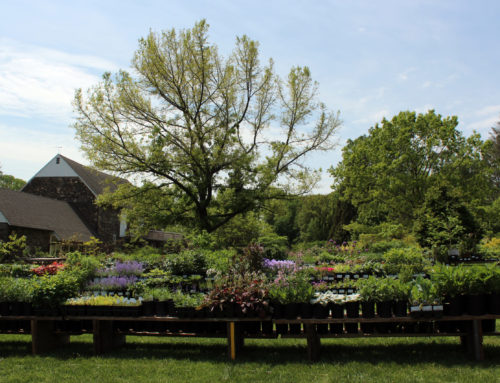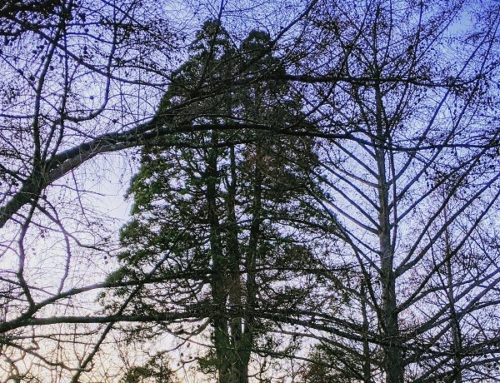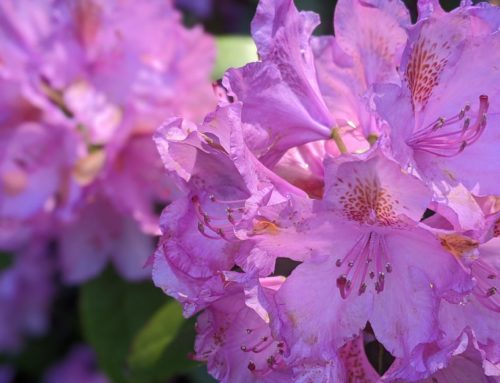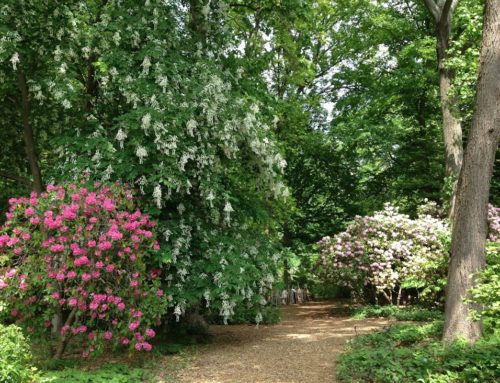“To the right are lofty woods, and beneath them the leaf-mold of a thousand years. On this steep shaded slope, on this rich earth, is the showy orchis by the hundred…In this nook, sheltered by hills clothed with woods, everything is as it should be. The bloodroot and anemone, the tall snakeroot and the blue cohosh grow unmolested within the sound of the falling water. Here also lurks that queer orchid, the Adam-and-Eve, but it takes some finding…”
An excerpt from “The Painter Arboretum and Dismal Run” written by T. Chalkley Palmer in 1929 for The Westonian.
In this paper written nearly 100 years ago, we find a record of the time, a brief snapshot of what Tyler looked like in those days. The friend and neighbor of this land who made this record is gone, but if he were able to walk these forest paths once more, I expect he would find them much the same.
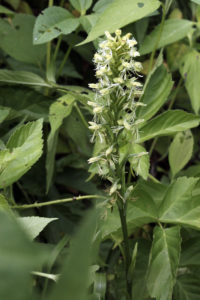
Galearis spectabilis, showy orchis
But what about the plants Chalkley names: the bloodroot (Sanguinaria canadensis), the tall snakeroot (Agerantina altissima) and the blue cohosh (Caulophyllum thalictroides)? They too remain much the same, as do the showy orchis (Galearis spectabilis). And the so-called ‘queer orchid’ the Adam-and-Eve? What about that strange-sounding plant, noted here as a one that ‘takes some finding’?
That population survives as well, which is perhaps more remarkable now than it was more than a century ago. The Adam-and-Eve orchid, also called the puttyroot orchid (Aplectrum hyemale), is rare or endangered throughout much of its native range. It can still be found throughout the East Coast, with its most southern populations in Northern Florida and its most northern colonies stretching into Canada. However, throughout that range, it is listed as ‘threatened’, ‘rare’ or ‘endangered’ by the USDA.
It’s a fascinating orchid, in part because its adaptive strategy is so different from the other members of its family. In the autumn when most perennial plant leaves in our region are turning brown and dying back to the ground, or at the very least slowing their growth, puttyroot does the opposite. Its new leaves for the year emerge in the autumn, when the tree leaves fall and the canopy opens to allow more light to reach the forest floor. The plants around the puttyroot are going dormant…but this orchid is just getting started.
Botanically, this is unusual. Photosynthetic function typically slows down in the winter in our region. Even the evergreen trees who keep their needles year round generally don’t work as hard as they do in the summer. Not so for the puttyroot orchid, which manages to photosynthesize down to the astonishingly chilly 35.6 degrees Fahrenheit, long past the point where most other plants have shut down (In Defense of Plants). This incredible ability allows puttyroot to produce energy for itself through the fall and long into the winter and then again in the early spring. Its leaves can survive being buried in feet of snow, and once revealed by snowmelt, can pick right up where it left off.
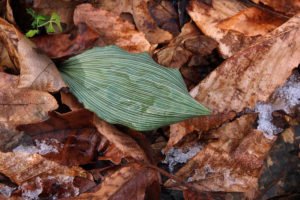
Aplectrum hyemale, puttyroot leaf
This strategy allows the puttyroot to capture all of the late fall and early spring sunlight before it has any competition from other plants, like the deciduous trees that shade the forest floor through the summer and fall. In April, as the trees begin to leaf out and other plants emerge, the leaves of puttyroot die back to be replaced by a single flower stalk, which blooms in May and June, along with our other native orchid species. Because it doesn’t flower surrounded by leaves, it can be easy to lose puttyroot in the leaf litter of the forest floor. You can walk right past it if you don’t know it’s there. It is a secret that the woods keep well.
So why does it matter that we have a population of it growing at Tyler? And why is it remarkable that we can trace that population back through history? It’s first mentioned in the paper presented by H. S. Conard in 1898, but it appears again in surveys done in the area in 1962. This is a population of a rare plant whose history we can reliably trace – at least back to the turn of the last century.
The fact of the matter is that these ephemeral woodland plants are uniquely vulnerable to disturbance. The survey conducted in 1962 notes that in order to protect these plants, their exact names and locations would be omitted when the species list was given to the general public in order to protect these plants from foragers. Even today, the pressures of people harvesting the fiddleheads of ferns and digging ramps put the puttyroot orchid at risk in Tyler’s woods. So many of these plants have long been used by people for food or medicine. Puttyroot gets its common name from the fact that early settlers in the area made a paste from its roots for use in repairing plates, bowls and cups. Once a plant has been pulled up and its roots used, that plant and its genetics, its legacy, and its hope of continuing its species into the future, are gone forever.
The forests, meadows, hills and stream banks of Tyler’s Natural Areas provide a safe haven for plants like the puttyroot orchid because the Arboretum preserves these areas as open space. Had the forested land where the puttyroot grows been sold to developers, this population would have long been lost; paved over for parking lots, houses or shopping malls. Instead it remains, growing as it has for at least a century.
There is still more to do. It isn’t enough simply to keep the forest intact. We must also record these plants, share our knowledge that this population exists and that it is here now. We must work with other conservation organizations to actively preserve the genetics of these species so that we can grow their populations. We must teach people about the treasures that can still be found in the forests around us, and encourage people to leave those treasures alone to allow them thrive and grow so that our children and grandchildren might discover them as well. The presence of the species that share soil in the forests of Pennsylvania is the legacy, not only of Tyler Arboretum, but of every person who calls this area home.
If you are interested in adding puttyroot to your home garden we will be offering it for sale at our upcoming plant sale to be held the first weekend in May!


